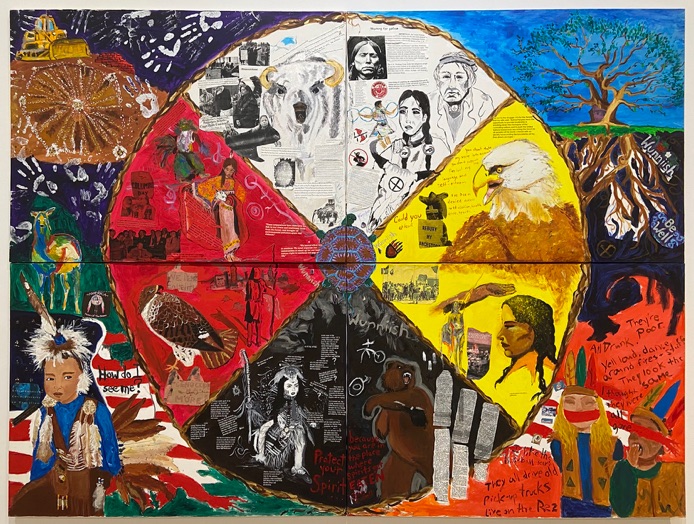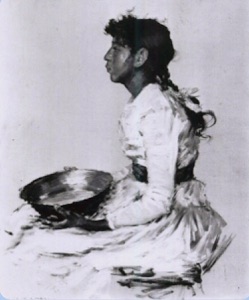now
About
Kelly Dennis (b. Dec. 30, 1984) is a Shinnecock visual artist. Her art works draw from the symbols of the Medicine Wheel for teachings that confront histories of colonization, misconceptions, stereotypes, racism, historical trauma, and challenges Kelly faces personally as an Indigenous woman and professionally as an attorney. And as an elected (2021) Shinnecock Council of Trustees tribal leader, Councilwoman Secretary; Member of the First-Ever Secretary’s Tribal Advisory Committee (2022). She works with Niamuck Land Trust and Shinnecock Grave Protection Warrior Society to protect Indigenous ancestor graves and advocate for Southampton Town laws to stop overdevelopment in and around the sacred Shinnecock Hills. Kelly has been actively engaged in many local organizations including Peconic Land Trust as a Project Committee Member. In addition, Kelly supports the Shinnecock Kelp Farmers in initiatives that help to reduce the impacts of climate change and embrace traditional practices and historical connection to the water and water resources. Kelly is a donor and volunteer for Ma's House & BIPOC Art Studio where she has supported many of the artists who have had residencies at Ma's House including giving tours of the Shinnecock Reservation and surrounding ancestral territory. Kelly began re-embracing her passion for the arts in 2017 while working as the Public Programs and Residency Coordinator at The Watermill Center (WMC), an interdisciplinary laboratory for the arts and humanities, until 2021. She continues to maintain a strong bond with WMC and the Byrd Hoffman Water Mill Foundation nonprofit, making connections between artists at WMC and Ma's House, opens WMC Community Day with Indigenous Land Acknowledgements, offers Algonquian cultural songs while playing hand drum, and performs traditional Eastern Woodland Blanket dancing at events.
Kelly Dennis
Kelly Dennis
Medicine Wheel Musháyu “large” Mixed Media 2003
Inaugural Artist Residency in the Cottage, originally Carriage House of William Merritt Chase


William Merritt Chase, Shinnecock Indian Girl Oil on Canvas 1892

Ulf Skogsbergh, Portrait of Kelly
in the Cottage 2022
Hope Sandrow and Ulf Skogsbergh welcome Kelly Dennis as the inaugural visiting artist-in-residence at their studio space in the Shinnecock Hills. The studio is within Indigenous Shinnecock ancestral territory designated as a Critical Environmental Area (CEA) for the Shinnecock Indian Contact Period Village Fort (designated 1988) and is included in the Cultural Resources Protection Overlay District (est. 2021). Kelly feels drawn to create art in this space due to its unique history and the connection she holds as Shinnecock Indian Nation tribal member longing to find time and space to reflect and find healing through painting. Hope and Ulf offered Kelly their artist residency after Kelly’s paintings entitled Medicine Wheel Musháyu “large” (2003, mixed media) and Medicine Wheel Piwáhcu “small” (2022, acrylic and wampum) were put on display at OUTCROPPING – INDIGENOUS ART NOW at Southampton Arts Center curated by Kelly’s brother Jeremy Dennis. Both paintings embrace spiritual wellness teachings of the four sacred directions and colors shared among many Native American Nations. The symbols Medicine Wheel teachings confront violent histories of colonization, misconceptions, stereotypes, racism, historical trauma, and present challenges Kelly faces personally as an Indigenous woman and professionally as an attorney and now an elected Shinnecock Council of Trustees tribal leader.
Kelly’s inspiration comes from her mother Denise Silva-Dennis, a visual artist and teacher who led a tribal community effort to paint a mural on the Shinnecock Community Center in the early 1990s that includes the Medicine Wheel within its center. Kelly credits her mother for encouraging her to find time to paint again for her mental health, self-care, and self-preservation in these uncertain times when she feels overwhelmed and overburdened. Kelly’s mother also feels drawn to Hope and Ulf’s studio space in the Shinnecock Hills: “My mom always felt a pull when turning the corner near this studio space. I’d see her gaze up the hill and we’d both imagine the ceremonies there so close to the Sugar Loaf Hill Shinnecock Burial Ground sacred site. It must be blood memory.”
Until 1859, Shinnecock people lived freely in the Shinnecock Hills and their graves were placed at high points facing west to be guided to the Spirit World through the sunset. Many graves have been desecrated after the Shinnecocks’ land was transferred to the Southampton Town Proprietors in of the Indian Non-Intercourse Act. Stone markers are visible at the Spellman property west of Hope and Ulf’s studio space that signify Shinnecock ancestral burials for preservation and protection.
After the Shinnecock people were removed from the Shinnecock Hills, Samuel L. Parrish, president of the Long Island Improvement Society, LIRR president, and arts patron sold the land where Hope and Ulf’s studio is located to Jane B. Colt, one of the first women to own property. The studio space is within William Merritt Chase's Carriage House that was moved to the property as part of the Jane B. Colt Estate in the Shinnecock Hills. In 1948, it became a summer home and studio of sculptor Madeleine Goodfriend Schonberger with her family.
Once Hope shared the history of the studio space as the Carriage House Kelly immediately thought of the “Shinnecock Indian Girl” ca. 1892 oil on canvas painting made by William Merritt Chase Romaine Williams holding a milk pan. Kelly had first seen a reproduction of this painting at a Parrish Art Museum exhibit stating: “The oil sketch Shinnecock Indian Girl (Romaine) is a sensitive profile portrait of a favorite model holding a brass bowl… ‘a young girl who senses the awakened conscience of girlhood just making itself felt.” William Merritt Chase and his students at the Shinnecock Hills Summer School of Art regularly engaged models from the Shinnecock Reservation who were willing to pose in exchange for a modeling fee. Some Shinnecock, including John Thompson, worked for Chase and his daughter as well as others posed for Chase and his students who were charged $1 each if they wished to sketch on the Reservation (Gaynell Stone, The Shinnecock Indians, p. 272).
Like Chase’s painting of Shinnecock ancestor Romaine Williams in what may be an awakened conscience of girlhood, in Medicine Wheel Musháyu Kelly includes a portrait of her younger brother, Jeremy, as he wonders how he sees himself and how he can use the Medicine Wheel teachings to guide his path in life as a young boy, dressed in his traditional regalia their mother made him for powwow. Behind him is an American flag with Native American children depicted as the stars who were taken away from their families and sent to Indian Boarding Schools where they were forbidden to acknowledge their heritage or speak their language, many suffered from abuse and died. Kelly seeks to learn more about the Shinnecock children who were taken from their parents and sent to boarding schools such as Thomas Indian School, Carlisle Indian School, and sanatoriums. Kelly hopes to spend her time at Hope and Ulf’s studio studying this past, the resilience of Shinnecock ancestors, and drawing and painting to find strength for present and future generations.
Kelly Dennis, Artist Statement